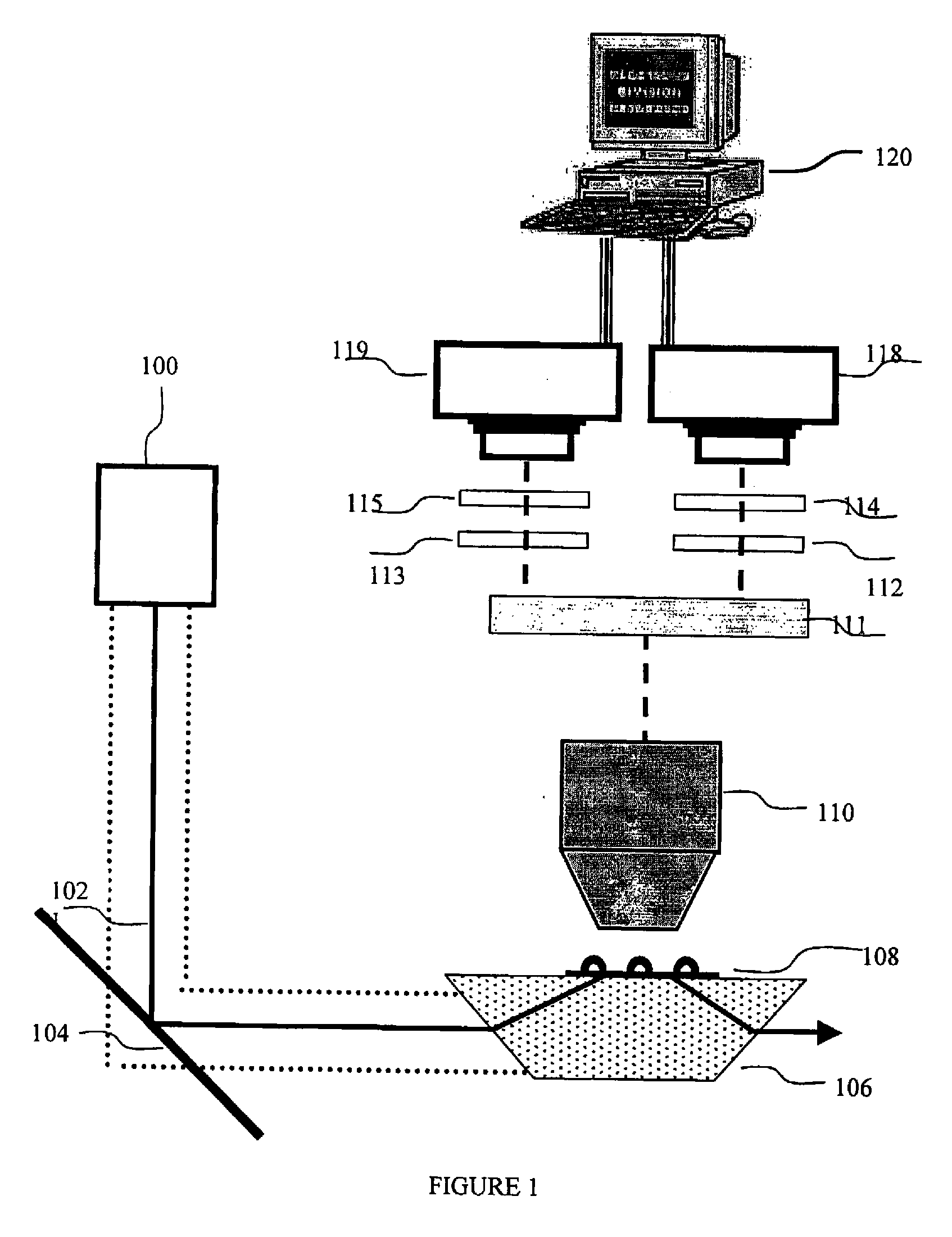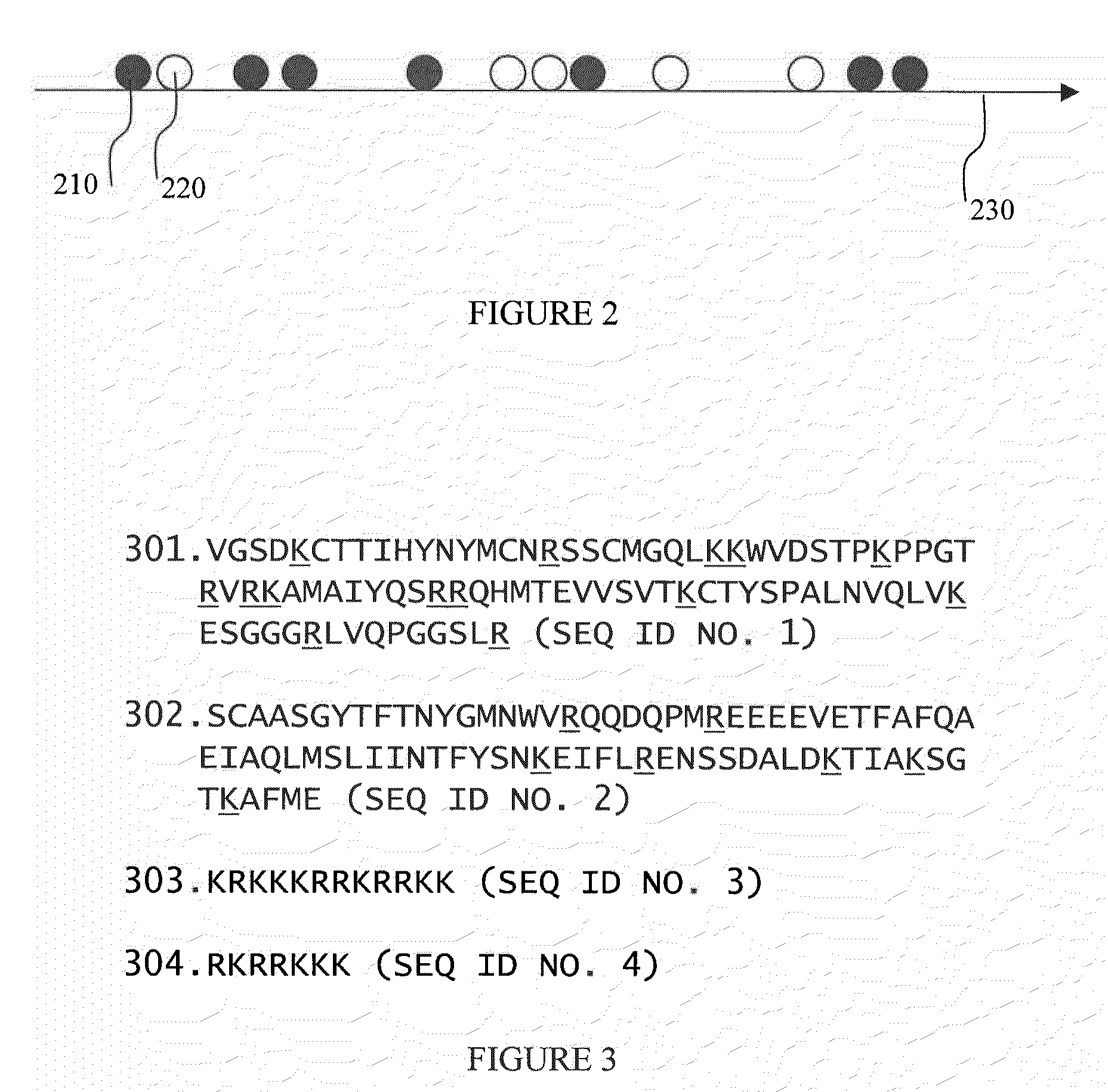Methods for evaluating ribonucleotide sequences
a ribonucleotide sequence and sequence technology, applied in the field of methods for evaluating ribonucleotide sequences, can solve the problems of inability to analyze only partial products of gene products, inability to design and produce chips, inaccurate quantitation and insensitivity to mrna isoforms,
- Summary
- Abstract
- Description
- Claims
- Application Information
AI Technical Summary
Benefits of technology
Problems solved by technology
Method used
Image
Examples
example 1
RNA Identification with Two Donors and Amino-Acid Labeling
[0089]FIG. 1 describes one optional but preferred embodiment for an exemplary apparatus for data acquisition, based on a wide-field microscope equipped with TIR (Total internal reflection, a microscopy illumination method that illuminates a volume at the interface of two materials with different refractive indices) illumination and intensified CCD camera. This setup is useful for in-vitro single-molecule protein synthesis monitoring application, where the ribosomes are immobilized on the microscope slide.
[0090]In this preferred embodiment the ribosome is labeled with one or two quantum dots as fluorescent donors. A ribosomal protein, such as optionally and preferably L1, is first biotinylated using FluoReporter Biotin-XX protein labeling kit (Molecular Probes, cat# F-2610) according to manufacturer protocol. Then, the biotinylated protein is linked to Qdot™ 525 Streptavidin Conjugate (QuantumDot) according to manufacturer pro...
example 2
tRNA Labeling and Usage
[0096]In this preferred embodiment the acceptor fluorphore is attached to one or more species of tRNA. Methods of labeling tRNA are discussed in detail in WO2004 / 050825. The labeled tRNAs are known to be processed normally both by ribosome and by the cognate synthetases.
[0097]Ribosome labeling is performed using one of several preferred methods. These include labeling with naturally fluorescent proteins, with organic dyes, and with semiconductor quantum dots. Labeling strategies included labeling ribosomal proteins such as ribosomal proteins L1, S1, S21 and others; In addition, 3′ and 5′ ends of 5S, 16S and 23S rRNA have been labeled (Robbins and Hardesty, Biochemistry. 1983, 22; 22(24):5675-5679).
[0098]For in-vitro labeling, there are several strategies. Organic dyes can be used to label ribosomal proteins using standard protein labeling techniques. Suppliers of these dyes publish detailed protocols describing their use. General procedures label proteins thro...
example 3
Amino Acid Labeling
[0102]In contrast with in-vivo applications of PSM, for RNA identification amino-acid labeling could be the method of choice since the functionality of the protein is not crucial, and since amino acids can be labeled relatively easily.
[0103]There are several ways of fluorescent labeling for amino acids in a cell free translation system. One way is to introduce labeled amino acids into the system. In this case one has to verify that the cognate synthetases function normally for charging the tRNAs with the labeled amino acid. For this step, it may be required to optimize the structure of the synthetases. Methods for high-throughput adaptation of synthetases for unnatural or labeled amino acids are discussed for example in Santoro et al, Nat. Biotechnol., 20:1044-1048 2002. In such cases it is important that no unlabeled amino acid of this type exist in the system, to avoid confounding the PSM signal sequence. To achieve this, a synthetic construction of the cell fre...
PUM
| Property | Measurement | Unit |
|---|---|---|
| distance | aaaaa | aaaaa |
| energy transfer | aaaaa | aaaaa |
| fluorescent | aaaaa | aaaaa |
Abstract
Description
Claims
Application Information
 Login to View More
Login to View More - R&D
- Intellectual Property
- Life Sciences
- Materials
- Tech Scout
- Unparalleled Data Quality
- Higher Quality Content
- 60% Fewer Hallucinations
Browse by: Latest US Patents, China's latest patents, Technical Efficacy Thesaurus, Application Domain, Technology Topic, Popular Technical Reports.
© 2025 PatSnap. All rights reserved.Legal|Privacy policy|Modern Slavery Act Transparency Statement|Sitemap|About US| Contact US: help@patsnap.com



